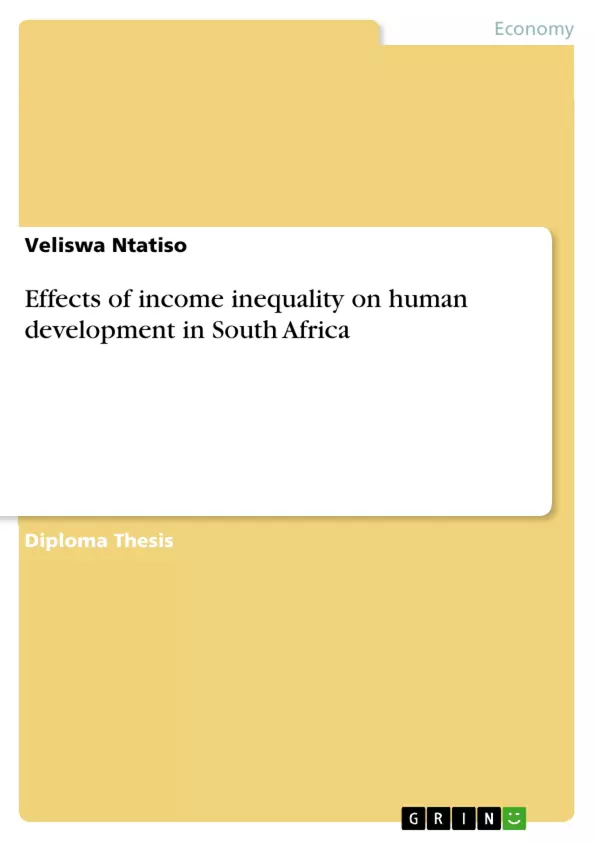The purpose of this study was to determine whether, between 1998 and 2018, income inequality in Southern Africa had an effect on human development.
The current study focuses on analyzing, using Quantec Easy data, how income disparity (as assessed by the Gini Coefficient) affects development (as measured by the HDI) in South Africa. To determine co-integration and whether there is a long-term connection between income disparity and human evolution, the Autoregressive Distributed Lag (ARDL) model was employed in conjunction with the Error Correction Model (ECM). The series' stationarity, which is a mixture of I(0) and I(1), was one of the factors that led to the selection of the ARDL model.
Inhaltsverzeichnis (Table of Contents)
- Chapter 1: Introduction of the study.
- 1.1 Introduction.
- 1.2. Statement of the research problem.
- 1.3. Research Objectives.
- 1.4. Hypothesis testing.
- 1.4.1 Null hypothesis.
- 1.4.2 Alternative hypothesis
- 1.5. Justification of the study.
- 1.6. Ethical consideration.
- 1.7. Delimitation of the study.
- 1.8. Layout of the dissertation
- Chapter 2: The Overview of income inequality effects on human development.
- 2.1 Introduction.
- 2.2 human development.
- 2.3 Income inequality.
- 2.4 The Gini Coefficient.
- 2.5 Comparison of human development in South Africa versus other regions.
- 2.6. An overview of the South African income inequality.
- 2.7 An overview of the South Africa's GDP
- 2.8 Conclusion
Zielsetzung und Themenschwerpunkte (Objectives and Key Themes)
This mini-dissertation aims to investigate the relationship between income inequality and human development in South Africa between 1998 and 2018. Using data from Quantec Easy, the study examines the impact of income disparity, measured by the Gini Coefficient, on human development, assessed by the Human Development Index (HDI). The research employs the Autoregressive Distributed Lag (ARDL) model in conjunction with the Error Correction Model (ECM) to identify long-term relationships between income disparity and human development.
- Impact of income inequality on human development in South Africa.
- Analysis of the relationship between the Gini Coefficient and the HDI.
- Application of the ARDL model and ECM to assess long-term co-integration.
- Exploring the role of factors like life expectancy, years of schooling, and income inequality on human development.
- Developing policy recommendations to mitigate the negative effects of income inequality.
Zusammenfassung der Kapitel (Chapter Summaries)
Chapter 1 introduces the research problem, outlining the study's objectives and hypotheses. It also discusses the justification for the research, ethical considerations, delimitations, and the dissertation's structure. Chapter 2 provides an overview of the relationship between income inequality and human development. It defines human development, explores income inequality, examines the Gini Coefficient, and compares human development in South Africa to other regions. This chapter also presents an overview of South Africa's income inequality and GDP.
Schlüsselwörter (Keywords)
The study focuses on the keywords: income inequality, South Africa, human development, Life expectancy at birth, Expected years of schooling, mean years of schooling, ARDL model, Gini Coefficient, and Human Development Index.
- Arbeit zitieren
- Veliswa Ntatiso (Autor:in), 2023, Effects of income inequality on human development in South Africa, München, GRIN Verlag, https://www.grin.com/document/1402107



